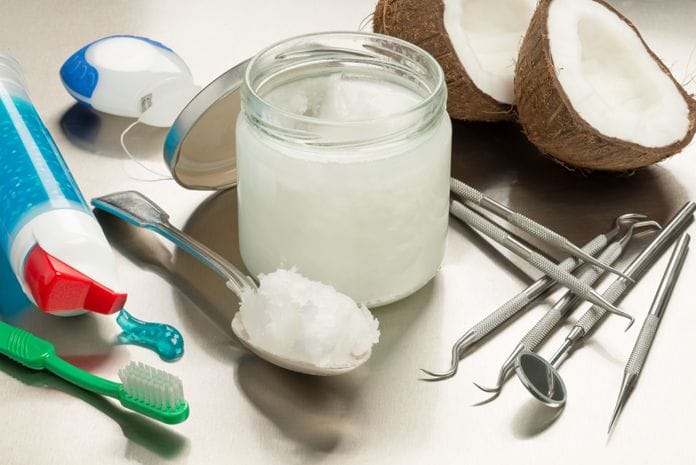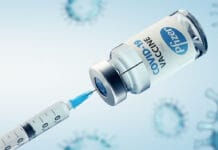Oil pulling and its supposed health benefits has been making the rounds for a few years now. You’ve probably even had a patient or two ask you about it. Spread through articles on social media and online blogs, oil pulling is touted as the latest and greatest way to improve oral health and purify your body.
As a dental hygienist, if you haven’t heard about this practice before, you are likely to have a patient bring it up sometime soon. The articles being shared on Facebook and written by natural health enthusiasts claim that oil pulling can improve or cure a wide range of ailments, from back migraines to diabetes to asthma.1 It’s also been touted to support hormonal imbalances, improve vision, reduce inflammation in bones and joints, and promote normal kidney function.2
So how, exactly, does one practice oil pulling? The technique is ancient and comes from Ayurvedic practices; it requires you to use pure vegetable oils. By swishing or “pulling” these pure oils around in your mouth for as much as 20 minutes, up to three times per day, you can remove harmful pathogens like bacteria and fungus from your mouth, teeth, gingiva, and even throat. The technique is supposed to dramatically affect overall health by activating enzymes that remove toxins from the blood.
As a hygienist, I focus on how or if oil pulling improves oral health. Some dental-specific claims for oil pulling include that it will stabilize mobile teeth, cure periodontal disease and dental caries, whiten teeth, and halt or even “fix” recession.
Oil Pulling and Dental Plaque
Dental plaque, just to review, is a bacterial biofilm that forms on teeth. It creates a polysaccharide matrix or physical barrier that protects bacteria from antibiotics, antiseptic rinses, and even your immune system. The strength of this biofilm is primarily why taking antibiotics to fight periodontal disease is largely ineffective.
For oil pulling to have any impact at all on tooth decay, the oils used would have to be able to break through this biofilm’s protective barrier. No scientific studies indicate that oil is able to penetrate the biofilm effectively. Dental researchers have found that mechanical or physical methods like brushing and interdental cleaning are the only way to break through this biofilm.
Oil Pulling and Periodontal Disease
Can oil pulling heal periodontal disease? It’s unlikely that the swishing technique could reach deep enough into periodontal pockets to be effective. Rinsing with mouthwash, for example, only reaches a maximum of 2 mm into a gingival sulcus. Most patients with gingivitis or periodontitis have pockets that well exceed this depth. That’s why rinsing has been proven in scientific studies to be a poor delivery method for getting liquid subgingivally.
Unfortunately, there’s no indication that thicker oil would be any more likely to penetrate deeper subgingivally. A reproducible study with a large sample size would have to prove that the specific vegetable oils used in oil pulling could do what other liquids cannot.
Scientific Studies on Oil Pulling
It’s important to identify who the authors of articles about oil pulling are. Is the article you’re reading written by a medical or dental professional or a scientific researcher? In most cases, they’re penned by people with little or no medical or dental training who offer only anecdotal evidence for the effectiveness of oil pulling.
If studies about oil pulling are cited in articles, is it possible to locate and check them? Sometimes, the blog articles cherry-pick information from the study and don’t look at the full results of the research.
One example I read referenced a study that found oil pulling was effective in reducing plaque after one to two weeks. However, when looking at the study, it showed that the control group, using chlorhexidine, saw similar improvements at 24 and 48 hours and one and two weeks.3 Perhaps the act of physically swishing for 20 minutes with anything is more important than the oil used. This specific study did not look at whether the mechanics of swishing provided the benefit or the oil itself. There’s also no mention of probing depths or bleeding indices, nor is there a control group that used only water or salt water. This study leaves more questions unanswered than proves any effectiveness of oil pulling.
More Reasons Why Oil Pulling is Unlikely to Benefit Oral Health
Let’s face it, do you have an extra 20 minutes, up to three times a day, to swish with oil? Brushing for two minutes twice a day, then cleaning interdentally in some way for a few minutes, takes much less time. It’s difficult enough to convince patients that they should spend the time to properly brush and floss! How can we talk people into taking up to an hour a day to swish with oil?
There are more issues with oil pulling. Patients who’ve tried the technique are reported to have experienced upset stomach, vomiting, and diarrhea.4 In a worst-case scenario, tiny droplets of oil could be inhaled and cause lipoid pneumonia.5
Then, there’s the issue with spitting the oil into the plumbing system. If your home is like most in the U.S., the pipes from the sink and toilet don’t function well when oil solidifies inside them. Clogged drains are the result.
What Does the American Dental Association Say About Oil Pulling?
The American Dental Association (ADA) has weighed in on the practice of oil pulling. Their statement says, “Currently, there are no reliable scientific studies to show that oil pulling reduces cavities, whitens teeth or improves oral health and well-being. Based on the lack of scientific evidence, the American Dental Association does not recommend oil pulling as a dental hygiene practice. The ADA continues to recommend that to maintain good dental health you brush twice a day for two minutes with fluoride toothpaste and floss between your teeth once a day and don’t use tobacco.”6
In Closing
It’s very true that a healthy mouth is needed for a healthy body. Oil pulling enthusiasts are right in wanting to improve their oral health to improve their overall well-being. Unfortunately, there’s simply not enough scientific evidence that shows oil pulling is the answer. More research is needed to have a good understanding of the technique and its effectiveness. I’d especially need to see if oil can reach the bottom of the gingival pocket or penetrate the biofilm barrier, among other questions I have. Until we have unbiased evidence of efficacy, I’ll have to stick with what’s already been scientifically proven.
References
- Bhandari, S. (2023, July 12). Is Oil Pulling the Silver Bullet It Is Touted to Be? Mya Care. https://myacare.com/blog/is-oil-pulling-the-silver-bullet-it-is-touted-to-be
- Hooda, R., Hooda, S., Sharma, R. Oil Pulling: A Wonderful Ayurvedic Therapy. International Journal of Pharmacognosy and Chinese Medicine. 2017; 1(2). https://medwinpublishers.com/IPCM/IPCM16000112.pdf
- Asokan, S., Rathan, J. Muthu, M.S. et al. Effect of Oil Pulling on Streptococcus mutans Count in Plaque and Saliva Using Dentocult SM Strip mutans Test: A Randomized, Controlled, Triple-blind Study. J Indian Soc Pedod Prev Dent. 2008; 26(1): 12-17.https://pubmed.ncbi.nlm.nih.gov/18408265/
4. Oil Pulling may Have Celebrity Believers, but Doctors Say It’s No Cure-all. (2014, May 22). University of Utah. https://healthcare.utah.edu/healthfeed/2014/05/oil-pulling-may-have-celebrity-believers-doctors-say-its-no-cure-all
5. Shanbhag, V.K.L. Oil Pulling for Maintaining Oral Hygiene – A Review. J Tradit Complement Med. 2017; 7(1): 106-109. https://www.ncbi.nlm.nih.gov/pmc/articles/PMC5198813/
6. Oil Pulling. (n.d.). American Dental Association: MouthHealthy. https://www.mouthhealthy.org/all-topics-a-z/oil-pulling











